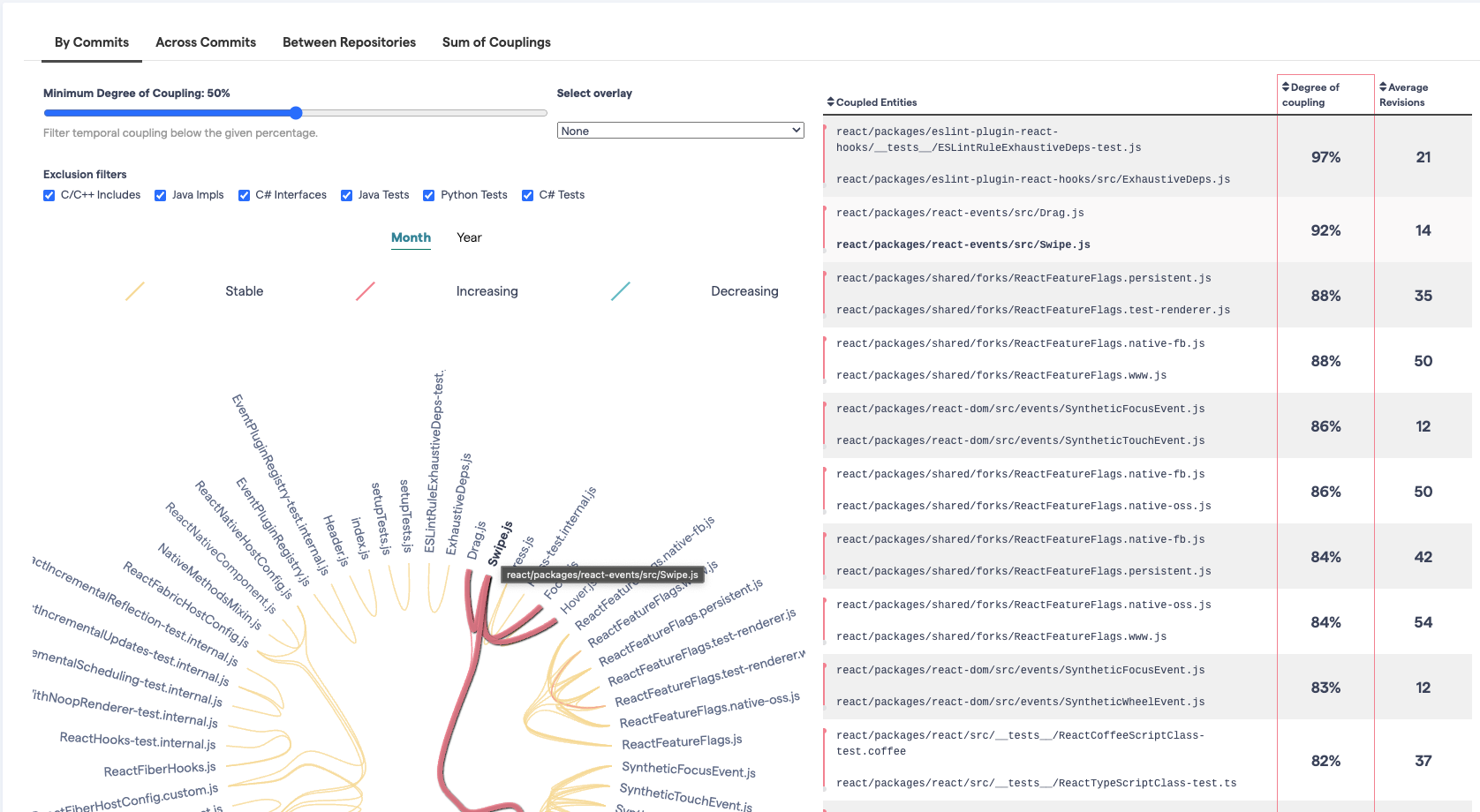Change Coupling: Visualize Logical Dependencies¶
Change Coupling means that two (or more) modules change together over time. Exploring the change coupling in our codebases often gives us deep and unexpected insights into how well our designs stand the test of time.
Most users first discover change coupling dynamically when using CodeScene’s Hotspot map. The specifics of that interface are documented here: Technical Debt.
Change coupling is also used to evaluate how well a software architecture aligns with the organizational structure of the teams that build the system.
Note that change coupling is an advanced analysis. As such, it’s usage frequency is lower than the hotspots and technical debt analyses. We find that a change coupling analysis provides valuable feedback in a team retrospective or as weekly architectural feedback.
Understand Change Coupling¶
CodeScene provides several different metrics for change coupling. The tool considers two modules coupled in time:
if they are modified in the same commit, or
if they are modified by the same programmer within a specific period of time, or
if they refer to the same Ticket ID in their commit messages.
Change coupling in itself is neither good nor bad; it all depends on what modules are coupled and for what reason they co-evolve. Hence, we recommend using change coupling to visualize the actual, logical dependencies in your codebase and compare this information to your architectural principles. Any deviations might indicate real problems.
Visualize System Aspects using Change Coupling¶
By default, CodeScene shows a hierarchical view of your change coupling. Hover over a label in the graph to highlight its dependants as illustrated in Fig. 107.

Fig. 107 Hover over a file in the change coupling graph to see its dependants.¶
The different colors of the connecting lines illustrates the temporal dimension of the dependency: does it grow stronger (red), decreases (blue), or remains stable (yellow)? This trend information lets you follow-up on the effect of architectural changes.
CodeScene also lets you capture logical system dependencies that cross team-boundaries:

Fig. 108 Visualizing change coupling across architectural components (example from React).¶
The preceding figure shows you how to uncover dependencies in a monolithic architecture. The cool thing with CodeScene’s change coupling is that the same analysis works equally well visualize the change impact in a microservice or other distributed architectures.
Investigate Logical Dependencies across Architectural Boundaries¶
Now, let’s say that those components are potentially developed and owned by different development teams. If that’s the case, the coordination costs in the organization might soar as new features and bug fixes require work by multiple teams before they can be completed.
CodeScene provides a second overlay that lets you visualize the team aspect of change coupling:

Fig. 109 Visualizing logical dependencies across team boundaries (example from React).¶
This visualization presents the same codebase as above, only now it’s grouped based on the main contributing team in each service.
Advanced Analyses: X-Ray your Logical Dependencies¶
When you find an unexpected dependency, you often have to dig into the code and understand why. This is where CodeScene’s X-Ray feature proves invaluable as it lets you X-Ray a change coupling clusters. Check out the guide in X-Ray for more details and examples.
Sum of Couplings¶
By summing how many times a module has been coupled to another one in a commit we get a measurement called sum of couplings. This is a way to find modules that are architecturally significant. The higher the number, the more central the module is in the codebase. The Sum of Couplings view gives you a table of files sorted by this metric.